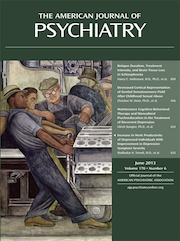“A Rose Is a Rose Is a Rose”?
To the Editor: I challenge the assertion in the January editorial by Freedman et al. (1) on DSM-5 reliability statistics that posttraumatic stress disorder (PTSD) “is another historic accomplishment, with a kappa of 0.67.” Since the majority of the 960 adult PTSD patients who were sampled for DSM-5 were interviewed at Veterans Affairs facilities, high rater concordance is not surprising (2). The notoriety and secondary gain associated with this disorder at these treatment locations probably concretized patients’ diagnostic self-identifications, which were most likely communicated to and adopted by the research interviewers.
The editorial quotes the statement by Robins and Guze that reliability is the “first test of validity for diagnosis” (3). But “first” refers to time sequence only, not to the word “foremost.” Validity, estimating the truth or falsity of scientific propositions, requires meeting three additional criteria. First, distinct boundaries must separate a disorder from other disorders. But the comorbidity of PTSD with generalized anxiety disorder, depression, and substance dependence (4) fails this requirement. Second, genetic aggregation should characterize family members of individuals diagnosed. Genetic association studies of PTSD have identified promising candidates such as the serotonin transporter gene (SLC6A4) (5). But robust confirmation requires extensive research efforts devoted to this gene and other suspects, requiring sample sizes possibly in the thousands. And third, the diagnosis must be substantiated by quantitative evidence (i.e., biological assays, brain imaging, or psychological tests). But pervasive contradictions and conflicting claims bedevil PTSD studies examining the morphology of the hippocampus and measures of substances such as catecholamines, cortisol, or glutamates.
Kendler (6) proposed a fifth widely accepted validity criterion: a diagnosis must generate relevant treatment benefits. But the 2008 Institute of Medicine evaluation of 53 medication interventions and 37 psychotherapy studies concluded that there was insufficient evidence of beneficial long-term treatment effects from any PTSD intervention with the exception of prolonged exposure therapy (7). Little has changed since then.
Applying the above five criteria for the validity of a psychiatric diagnosis to PTSD gives it a weak position in DSM-5 nosology.
1 : The initial field trials of DSM-5: new blooms and old thorns. Am J Psychiatry 2013; 170:1–5Link, Google Scholar
2 : DSM-5 field trials in the United States and Canada, part I: study design, sampling strategy, implementation, and analytic approaches. Am J Psychiatry 2013; 170:43–58Link, Google Scholar
3 : Establishment of diagnostic validity in psychiatric illness: its application to schizophrenia. Am J Psychiatry 1970; 126:983–987Link, Google Scholar
4 : DSM-5 field trials in the United States and Canada, part II: test-retest reliability of selected categorical diagnoses. Am J Psychiatry 2013; 170:59–70Link, Google Scholar
5 Genetics of post-traumatic stress disorder: review and recommendations for genome-wide association studies. Curr Psychiatry Rep 2010; 12:313–326Crossref, Medline, Google Scholar
6 : Toward a scientific nosology: strengths and limitations. Arch Gen Psychiatry 1990; 47:969–973Crossref, Medline, Google Scholar
7



